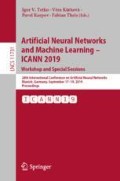Abstract
Neural network has a critical problem, called catastrophic forgetting, where memories for tasks already learned are easily overwritten with memories for a task additionally learned. This problem interferes with continual learning required for autonomous robots, which learn many tasks incrementally from daily activities. To mitigate the catastrophic forgetting, it is important for especially reservoir computing to clarify which neurons should be fired corresponding to each task, since only readout weights are updated according to the degree of firing of neurons. We therefore propose the way to design reservoir computing such that the firing neurons are clearly distinguished from others according to the task to be performed. As a key design feature, we employ fractal network, which has modularity and scalability, to be reservoir layer. In particular, its modularity is fully utilized by designing input layer. As a result, simulations of control tasks using reinforcement learning show that our design mitigates the catastrophic forgetting even when random actions from reinforcement learning prompt parameters to be overwritten. Furthermore, learning multiple tasks with a single network suggests that knowledge for the other tasks can facilitate to learn a new task, unlike the case using completely different networks.
Supported by JSPS KAKENHI, Grant-in-Aid for Young Scientists (B), Grant Number 17K12759.
Access this chapter
Tax calculation will be finalised at checkout
Purchases are for personal use only
References
Bartumeus, F., da Luz, M.E., Viswanathan, G., Catalan, J.: Animal search strategies: a quantitative random-walk analysis. Ecology 86(11), 3078–3087 (2005)
Ellefsen, K.O., Mouret, J.B., Clune, J.: Neural modularity helps organisms evolve to learn new skills without forgetting old skills. PLoS Comput. Biol. 11(4), e1004128 (2015)
French, R.M.: Catastrophic forgetting in connectionist networks. Trends Cogn. Sci. 3(4), 128–135 (1999)
Jaeger, H., Haas, H.: Harnessing nonlinearity: predicting chaotic systems and saving energy in wireless communication. Science 304(5667), 78–80 (2004)
Kirkpatrick, J., et al.: Overcoming catastrophic forgetting in neural networks. Proc. Nat. Acad. Sci. 114(13), 3521–3526 (2017)
Kobayashi, T.: Check regularization: combining modularity and elasticity for memory consolidation. In: Kůrková, V., Manolopoulos, Y., Hammer, B., Iliadis, L., Maglogiannis, I. (eds.) ICANN 2018. LNCS, vol. 11140, pp. 315–325. Springer, Cham (2018). https://doi.org/10.1007/978-3-030-01421-6_31
Kobayashi, T.: Student-t policy in reinforcement learning to acquire global optimum of robot control. Appl. Intell. (2019, Online first)
Konda, V.R., Tsitsiklis, J.N.: Actor-critic algorithms. In: Advances in Neural Information Processing Systems, pp. 1008–1014 (2000)
Krizhevsky, A., Sutskever, I., Hinton, G.E.: ImageNet classification with deep convolutional neural networks. In: Advances in Neural Information Processing System, pp. 1097–1105 (2012)
Luo, J., Edmunds, R., Rice, F., Agogino, A.M.: Tensegrity robot locomotion under limited sensory inputs via deep reinforcement learning. In: IEEE International Conference on Robotics and Automation, pp. 6260–6267. IEEE (2018)
McCloskey, M., Cohen, N.J.: Catastrophic interference in connectionist networks: the sequential learning problem. In: Psychology of Learning and Motivation, vol. 24, pp. 109–165. Elsevier, Amsterdam (1989)
Peters, J., Schaal, S.: Natural actor-critic. Neurocomputing 71(7–9), 1180–1190 (2008)
Remaki, L., Cheriet, M.: KCS-new kernel family with compact support in scale space: formulation and impact. IEEE Trans. Image Process. 9(6), 970–981 (2000)
Rozenfeld, H.D., Havlin, S., Ben-Avraham, D.: Fractal and transfractal recursive scale-free nets. New J. Phys. 9(6), 175 (2007)
Sutton, R.S., Barto, A.G.: Reinforcement Learning: An Introduction. MIT Press, Cambridge (1998)
Tsurumine, Y., Cui, Y., Uchibe, E., Matsubara, T.: Deep reinforcement learning with smooth policy update: application to robotic cloth manipulation. Robot. Auton. Syst. 112, 72–83 (2019)
Van Seijen, H., Mahmood, A.R., Pilarski, P.M., Machado, M.C., Sutton, R.S.: True online temporal-difference learning. J. Mach. Learn. Res. 17(145), 1–40 (2016)
Velez, R., Clune, J.: Diffusion-based neuromodulation can eliminate catastrophic forgetting in simple neural networks. PLoS ONE 12(11), e0187736 (2017)
Williams, R.J.: Simple statistical gradient-following algorithms for connectionist reinforcement learning. Mach. Learn. 8(3–4), 229–256 (1992)
Zenke, F., Poole, B., Ganguli, S.: Continual learning through synaptic intelligence. In: International Conference on Machine Learning, pp. 3987–3995 (2017)
Author information
Authors and Affiliations
Corresponding author
Editor information
Editors and Affiliations
Rights and permissions
Copyright information
© 2019 Springer Nature Switzerland AG
About this paper
Cite this paper
Kobayashi, T., Sugino, T. (2019). Continual Learning Exploiting Structure of Fractal Reservoir Computing. In: Tetko, I., Kůrková, V., Karpov, P., Theis, F. (eds) Artificial Neural Networks and Machine Learning – ICANN 2019: Workshop and Special Sessions. ICANN 2019. Lecture Notes in Computer Science(), vol 11731. Springer, Cham. https://doi.org/10.1007/978-3-030-30493-5_4
Download citation
DOI: https://doi.org/10.1007/978-3-030-30493-5_4
Published:
Publisher Name: Springer, Cham
Print ISBN: 978-3-030-30492-8
Online ISBN: 978-3-030-30493-5
eBook Packages: Computer ScienceComputer Science (R0)

